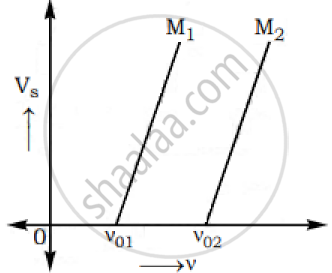Advertisements
Advertisements
प्रश्न
The energy of photon of wavelength X is_____ .
[h = Planck’s constant, c = speed of light in vacuum]
पर्याय
hcλ
`(hλ)/c`
`λ/(hc)`
`(hc)/λ`
उत्तर
`(hc)/lambda`
Energy of a photon E =`hv=(hc)/lambda`
APPEARS IN
संबंधित प्रश्न
The threshold wavelength of silver is 3800Å. Calculate the maximum kinetic energy in eV of photoelectrons emitted, when ultraviolet light of wavelength 2600Å falls on it.
(Planck’s constant, h =6.63 x 1O-34J.s.,
Velocity of light in air, c = 3 x 108 m / s)
The photoelectric threshold wavelength of a metal is 230 nm. Determine the maximum kinetic energy in joule and in eV of the ejects electron for the metal surface when it is exposed to a radiation of wavelength 180 nm.
[Planck’s constant : h = 6.63 * 10-34 Js, Velocity of light : C = 3 * 108 m/s.]
Find the value of energy of electron in eV in the third Bohr orbit of hydrogen atom.
(Rydberg's constant (R) = 1· 097 x 107m - 1,Planck's constant (h) =6·63x10-34 J-s,Velocity of light in air (c) = 3 x 108m/ s.)
State two important properties of photon which are used to write Einstein’s photoelectric equation.
Define (i) stopping potential and (ii) threshold frequency, using Einstein’s equation and drawing necessary plot between relevant quantities.
A proton and a deuteron are accelerated through the same accelerating potential. Which one of the two has less momentum?
Give reasons to justify your answer.
Write its S.I. unit of (intensity of radiation)
The work function for a metal surface is 2.2eV. If the light of wavelength 5000Å is incident on the surface of the metal, find the threshold frequency and incident frequency. Will there be an emission of photoelectrons or not? (c = 3 x 108 m/ s, 1eV = 1.6x10-19 J , h = 6.63 x 10-34 J.s.)
Einstein's photoelectric equation is:
a) `E_"max" = hlambda - varphi_0`
b) `E_"max"= (hc)/lambda varphi_0`
c) `E_"max" = hv + varphi_0`
d) `E_"max" = (hv)/lambda + varphi_0`
With reference to the photoelectric effect, define threshold wavelength
Write the basic features of photon picture of electromagnetic radiation on which Einstein’s photoelectric equation is based.
Which of the following graphs correctly represents the variation of maximum kinetic energy (Ek) of photoelectrons with the frequency (𝜈) of the incident radiation?
Calculate the maximum kinetic energy of photoelectrons emitted by a metal (work function = 1.5 eV) when it is illuminated with light of wavelength 198 nm.
Plot a labelled graph of |Vs| where Vs is stopping potential versus frequency f of the incident radiation. State how will you use this graph to determine the value of Planck's constant?
In an inelastic collision, which of the following does not remain conserved?
Radiations of two photon's energy, twice and ten times the work function of metal are incident on the metal surface successively. The ratio of maximum velocities of photoelectrons emitted in two cases is:
Dimensions of ‘resistance’ are same as (where h is Planck's constant and e is charge):
Threshold frequency for photoelectric effect on sodium corresponds to a wave length 5000. Its work function is ______.
Who indirectly determined the mass of the electron by measuring the charge of the electrons?
If the frequency of light in a photoelectric experiment is double the stopping potential will
The slope of frequency of incident light and stopping potential for a given surface will be
What will be wavelength of a photon of momentum 6.6 × 10–24 kgms–1?
The wavelength of matter is independent of
- Calculate the frequency of a photon of energy 6.5 × 10−19 J.
- Can this photon cause the emission of an electron from the surface of Cs of work function 2.14 eV? If yes, what will be the maximum kinetic energy of the photoelectron?
Ultraviolet light is incident on metals P, Q and R, having work functions 8 eV, 2 eV and 4 eV respectively,
- Which metal has lowest threshold frequency for photoelectric effect?
- For which metal is the value of Emax minimum?
(Note: Emax is maximum kinetic energy of the emitted photoelectrons.)
How does stopping potential in photoelectric emission vary if the frequency of incident radiation decreases?
The graphs below show the variation of the stopping potential VS with the frequency (ν) of the incident radiations for two different photosensitive materials M1 and M2.

Express work function for M1 and M2 in terms of Planck’s constant(h) and Threshold frequency and charge of the electron (e).
If the values of stopping potential for M1 and M2 are V1 and V2 respectively then show that the slope of the lines equals to `(V_1-V_2)/(V_(01)-V_(02))` for a frequency,
ν > ν02 and also ν > ν01
